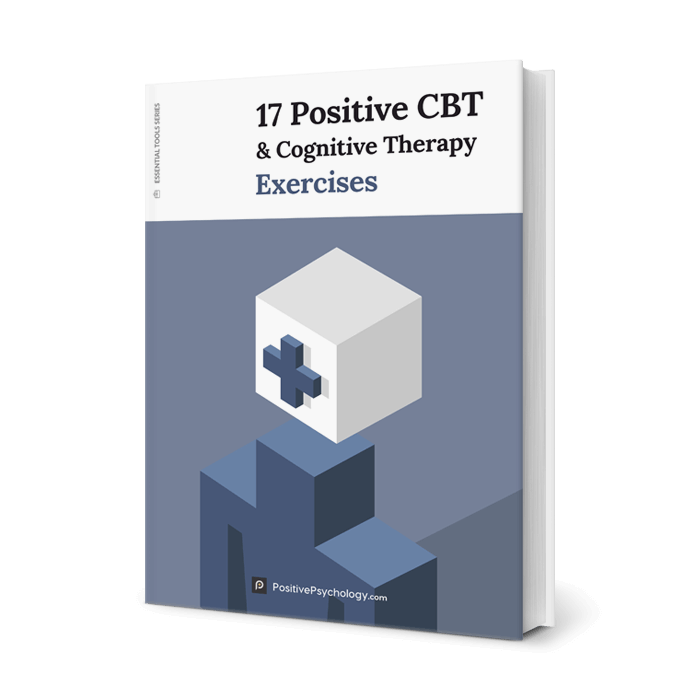Cognitive Remediation Therapy: 13 Exercises & Worksheets
 People experiencing mental health issues often have thinking and memory problems.
People experiencing mental health issues often have thinking and memory problems.
This can result in concentration, organizational, and planning difficulties that impact their quality of life and independent living.
Cognitive Remediation Therapy (CRT) helps by increasing awareness of intellectual difficulties and improving thinking skills. While originally designed for people with thinking problems associated with schizophrenia, it has also proven successful for those with other diagnoses (Bristol Mental Health, n.d.).
CRT works by encouraging a range of exercises and activities that challenge memory, flexible thinking, planning, and concentration problems.
This article explores CRT and its potential to help clients and includes techniques, activities, and worksheets to build effective therapy sessions.
Before you continue, we thought you might like to download our three Positive CBT Exercises for free. These science-based exercises will provide you with detailed insight into Positive CBT and give you the tools to apply it in your therapy or coaching.
This Article Contains:
What Is Cognitive Remediation Therapy (CRT)?
“Cognitive remediation is a behavioral treatment for people who are experiencing cognitive impairments that interfere with daily functioning” (Medalia, Revheim, & Herlands, 2009, p. 1).
Successful cognitive functions, including memory, attention, visual-spatial analysis, and abstract reasoning, are vital for engaging with tasks, the environment, and healthy relationships.
CRT improves cognitive processing and psychosocial functioning through behavioral training and increasing individual confidence in people with mental health disorders (Corbo & Abreu, 2018). Training interventions focus on the skills and supports required to “improve the success and satisfaction people experience in their chosen living, learning, working, and social environments” (Medalia et al., 2009, p. 2).
Exercises typically focus on specific cognitive functions, where tasks are repeated (often on a computer) at increasing degrees of difficulty. For example:
- Paying attention
- Remembering
- Being organized
- Planning skills
- Problem-solving
- Processing information
Based on the principles of errorless learning and targeted reinforcement exercises, interventions involve memory, motor dexterity, and visual reading tasks. Along with improving confidence in personal abilities, repetition encourages thinking about solving tasks in multiple ways (Corbo & Abreu, 2018).
While initially targeted for patients with schizophrenia, CRT is an effective treatment for other mental health conditions, including mood and eating disorders (Corbo & Abreu, 2018).
CRT is particularly effective when the cognitive skills and support interventions reflect the individual’s self-selected rehabilitation goals. As a result, cognitive remediation relies on collaboration, assessing client needs, and identifying appropriate opportunities for intervention (Medalia et al., 2009).
Cognitive remediation vs cognitive rehabilitation
CRT is one of several skill-training psychiatric rehabilitation interventions. And yet, cognitive remediation is not the same as cognitive rehabilitation (Tchanturia, 2015).
Cognitive rehabilitation typically targets neurocognitive processes damaged because of injury or illness and involves a series of interventions designed to retrain previously learned cognitive skills along with compensatory strategies (Tsaousides & Gordon, 2009).
How Does Cognitive Remediation Work?

While initially done in person, they can subsequently be performed remotely as required (Corbo & Abreu, 2018; Bristol Mental Health, n.d.).
Well-thought-out educational software provides multisensory feedback and positive reinforcement while supporting success, choice, and control of the learning process. Its design can target either specific cognitive functions or non-specific learning skills and mechanisms (Medalia et al., 2009).
CRT successfully uses the brain’s neuroplasticity and is often more effective in younger age groups who haven’t experienced the effects of long-term psychosis. It works by increasing activation and connectivity patterns within and across several brain regions involved in working memory and high-order executive functioning (Corbo & Abreu, 2018).
The Neuropsychological Educational Approach to Cognitive Remediation (NEAR) is one of several approaches that provide highly individualized learning opportunities. It allows each client to proceed at their own pace on tasks selected and designed to engage them and address their cognitive needs (Medalia et al., 2009).
NEAR and other CRT techniques are influenced by learning theory and make use of the following (Medalia et al., 2009):
- Errorless learning
Encouraging the client to learn progressively, creating a positive experience without relying on trial and error. - Shaping and positive feedback
Reinforcing behaviors that approximate target behaviors (such as good timekeeping) and offering rewards (for example, monthly certificates for attendance). - Prompting
Using open-ended questions that guide the client toward the correct response. - Modeling
Demonstrating how to solve a problem. - Generalizing
Learning how to generalize learned skills to other situations. - Bridging
Understanding how to apply skills learned inside a session outside in everyday life.
Encouraging intrinsic motivation (doing the tasks for the satisfaction of doing them rather than for external rewards) and task engagement are also essential aspects of successful CRT programs (Medalia et al., 2009).
Therapy is most effective when it successfully supports clients as they transfer learning skills into the real world.
8 Techniques for Your Sessions
Cognitive remediation techniques must be selected according to the skills and needs of the client and typically fall into one of three major intervention categories (Medalia et al., 2009):
- Strategy-based/compensatory approaches
Used to acquire skills to overcome or modify the environment to avoid cognitive difficulties, for example:- Planning exercises, such as planning a trip to the beach to practice cognitive strategies
- Cueing and sequencing, such as adding signs or placing reminder notes at home to encourage completing everyday tasks (for example, brushing teeth)
Such techniques rely on several key principles, including “(1) teaching new, efficient, information processing strategies; (2) aiding the transfer of cognitive gains to the real world; and (3) modifying the local environment” (Medalia et al., 2009, p. 5).
- Restorative approaches
Directly target cognitive deficits by repeating task practices and gradually increasing difficulty and complexity; along with regular feedback, they encourage accurate and high levels of performance.
Practice is often organized hierarchically, as follows:
-
- Elementary aspects of sensory processing (for example, improving auditory processing speed and accuracy)
- High-order memory and problem-solving skills (including executive functioning and verbal skills)
This technique assumes a degree of neuroplasticity that, with training, results in a greater degree of accuracy in sensory representations, improved cognitive strategies for grouping stimuli into more meaningful groups, and better recall.
- Social cognitive approaches
Focus on removing or reducing cognitive deficits by adopting other people’s objectives and retraining biases, and can involve:- Repetition and reaching for increasing levels of task difficulty
- Modeling other people’s positive behavior
- Role-play to re-enact experienced or imagined behavior from different perspectives
- Corrective feedback to improve and correct unwanted or unhelpful behavior
Complex social cognitive processes are typically broken down into elemental skills for repetitive practice, role-play, and corrective feedback.
Professor Dame Til Wykes: cognitive remediation therapy
7 Exercises, Activities, & Games
It is vital that activities within CRT are interesting and engaging for clients. They must foster the motivation required to persevere to the end of the task or game.
The following three games and puzzles are particularly valuable for children and adolescents (modified from Tchanturia, 2015):
1. SET
SET is a widely available card game that practices matching based on color, shape, shading, etc.
Clients must shift their thinking to identify multiple ways of categorizing and grouping cards, then physically sort them based on their understanding.
It may be helpful to begin with a limited set of cards to reduce the likelihood of the clients becoming overwhelmed by the game or finding it less enjoyable.
2. Rush Hour
Rush Hour is another fun game that balances problem-solving skills with speed.
Puzzles start simple and increase in complexity, with additional elements involved. Skills developed include problem-solving and abstract thinking, and the game requires a degree of perseverance.
3. Q-bitz

Other activities require no specialist equipment and yet can be highly engaging and support clients in learning transferable skills (modified from Tchanturia, 2015).
- Bigger picture thinking
This involves the client picturing a shape in their minds or looking at one out of sight of the therapist. They then describe the shape (without naming it), while the therapist attempts to draw it according to the instructions. This practice is helpful with clients who get overwhelmed by detail and cannot see the bigger picture. - Word searches
Word searches encourage the client to focus on relevant information and ignore everything else – an essential factor in central coherence. Such puzzles also challenge memory, concentration, and attention. - Last word response
Last word response is a challenging verbal game promoting cognitive flexibility. The first player makes up and says a sentence out loud. Each subsequent player makes up a new sentence, starting with the last word of the previous player’s sentence. For example, ‘I like cheese’ may be followed by the next player saying, ‘Cheese is my favorite sandwich ingredient,’ etc. - Dexterity
Using your non-dominant hand once a week (for example, combing your hair or brushing your teeth) stimulates different parts of your brain, creating alternative patterns of neuron firing and strengthening cognitive functions.
6 Helpful Worksheets and Manuals
The following therapy worksheets help structure Cognitive Remediation Therapy sessions and ensure that the needs of clients are met using appropriately targeted CRT interventions (modified from Medalia et al., 2009; Medalia & Bowie, 2016):
Client referral to CRT
The Cognitive Remediation Therapy Referral Form captures valuable information when a client is referred from another agency or therapist so that the new therapist can identify and introduce the most appropriate CRT interventions. The form includes information such as:
Primary reasons
- Paying attention
- Remembering
- Being organized
- Planning skills
- Problem-solving
- Processing information
Secondary reasons
- Self-confidence
- Working with others
- Time management
- Goal-directed activities
Cognitive Appraisal for CRT
The Cognitive Appraisal for CRT form is helpful for identifying and recording areas of cognitive processing that cause difficulty for the client and require focus during Cognitive Remediation Therapy sessions.
Clients are scored on their degree of difficulty with the following:
- Paying attention during conversation
- Maintaining concentration in meetings
- Remembering
- Completing tasks once started
- Starting tasks
- Planning and organizing tasks and projects
- Reasoning and solving problems
Software Appraisal for CRT
The Software Appraisal for CRT form helps assess which software would be most helpful in a specific Cognitive Remediation Therapy session. It provides valuable input for tailoring treatment to the needs of the client.
For example:
- Level of reading ability required
- Cognitive deficits addressed by the software
- What is the multimedia experience like?
- How much input is required by the therapist?
Appraisal records become increasingly important as more software is acquired for clients with various cognitive deficits from multiple backgrounds.
Software Usage for CRT
The Software Usage for CRT form helps keep track of the software clients have tried and how effectively it supports them as they learn, develop, and overcome cognitive deficits.
The client considers the software they use and whether they practiced the following areas of cognition:
- Problem-solving
- Concentration
- Processing speed
- Planning
- Multitasking
- Logic and reasoning
- Attention
- Organization
- Fast responses
- Working memory
- Memory
Thought Tracking During Cognitive Remediation Therapy
Thought Tracking During Cognitive Remediation Therapy is valuable for identifying and recording the client’s goals for that day’s Cognitive Remediation Therapy session and understanding how it relates to their overall treatment goals.
Planning to Meet Goals in CRT
The Planning to Meet Goals in CRT worksheet is for clients requiring support and practice in planning, goal-setting, and goal achievement.
Working with the client, answer the following prompts:
- What goal or project are you working toward?
- What date should it be completed by?
- Are there any obstacles to overcome to complete the goal?
- Are there any additional resources required?
- Then consider the steps needed to achieve the goal.
Other free resources
Happy Neuron provides several other free resources that are available for download.
Implementing Online CRT Programs

Consider the five Cs when selecting online CRT programs (modified from Medalia et al., 2009):
- Cognitive – What target deficits are being addressed?
- Client – What interests and level of functioning does the client have?
- Computer – What computing requirements and compatibility factors need to be considered?
- Context – Does the software use real-world or fantasy activities and environments? Are they age and cognitive ability appropriate?
- Choice – Is the learner given choice and options to adapt the activity to their preferences?
Once you’ve ordered the software, give it a thorough review to understand when it is most appropriate to use and with whom.
For online CRT programs to be effective as teaching tools and activities, they should include the following features (modified from Medalia et al., 2009, p. 53):
- Intrinsically motivating
- Active use of information
- Multisensory strategies
- Frequent feedback
- Control over the learning process
- Positive reinforcement
- Application of newly acquired skills in appropriate contexts
- Errorless learning – challenging yet not frustrating
Therapists must become familiar with each program’s content and processes so that targeted deficits are fully understood and clients are engaged without confusion or risk of failure.
3 Best Software Programs for Helping Your Clients
A great deal of software “targets different skills and offers a variety of opportunities for contextualization and personalization” (Medalia et al., 2009, p. 43).
We focus on three suppliers of extensive CRT software resources below (recommended by Medalia et al., 2009).
1. Happy Neuron
Happy Neuron provides a wide variety of online brain training exercises and activities to stimulate cognitive functioning in the following areas:
- Memory
- Attention
- Language
- Reasoning
- Visual-spatial
2. BrainHQ

When you’re performing well, the exercises become increasingly difficult.
The exercises are grouped into the following areas:
- Attention
- Brain speed
- Memory
- People skills
- Navigation
- Intelligence
3. Games for the Brain

A Take-Home Message
Cognitive difficulties, such as challenges with paying attention, planning, remembering, and problem-solving, can further compound and exacerbate mental health issues
While initially created for schizophrenia, CRT is also valuable for other mental health problems, including eating and mood disorders. Treatments are effective in one-to-one and group sessions, and lessons can be transferred to the outside world, providing crucial gains for a client’s mental wellbeing and social interaction.
Through repeated and increasingly challenging skill-based interventions, CRT benefits cognitive functioning and provides confidence gains to its users. The treatment adheres to learning theory principles and targets specific brain processing areas such as motor dexterity, memory, and visual-spatial perception, along with higher-order functioning.
Involving clients in treatment choices increases the likelihood of ongoing perseverance, engagement, and motivation as activities repeat with increasing degrees of difficulty.
This article offers a valuable starting point for exploring CRT and its benefits, with several worksheets and forms to encourage effective treatment.
We hope you enjoyed reading this article. For more information, don’t forget to download our three Positive CBT Exercises for free.
- Bristol Mental Health. (n.d.). Cognitive remediation therapy: Improving thinking skills. Retrieved December 15, 2021, from http://www.awp.nhs.uk/media/424704/cognitive-remediation-therapy-022019.pdf
- Corbo, M., & Abreu, T. (2018). Cognitive remediation therapy: EFPT psychotherapy guidebook. Retrieved December 15, 2021, from https://epg.pubpub.org/pub/05-cognitive-remediation-therapy/release/3
- Medalia, A., & Bowie, C. R. (2016). Cognitive remediation to improve functional outcomes. Oxford University Press.
- Medalia, A., Revheim, N., & Herlands, T. (2009). Cognitive remediation for psychological disorders: Therapist guide. Oxford University Press.
- Tchanturia, K. (2015). Cognitive remediation therapy (CRT) for eating and weight disorders. Routledge.
- Tsaousides, T., & Gordon, W. A. (2009). Cognitive rehabilitation following traumatic brain injury: Assessment to treatment. Mount Sinai Journal of Medicine: A Journal of Translational and Personalized Medicine, 76(2), 173-181.
Let us know your thoughts
Read other articles by their category
- Body & Brain (50)
- Coaching & Application (57)
- Compassion (26)
- Counseling (51)
- Emotional Intelligence (24)
- Gratitude (18)
- Grief & Bereavement (21)
- Happiness & SWB (40)
- Meaning & Values (26)
- Meditation (20)
- Mindfulness (45)
- Motivation & Goals (45)
- Optimism & Mindset (34)
- Positive CBT (29)
- Positive Communication (20)
- Positive Education (47)
- Positive Emotions (33)
- Positive Leadership (18)
- Positive Parenting (4)
- Positive Psychology (33)
- Positive Workplace (37)
- Productivity (17)
- Relationships (46)
- Resilience & Coping (38)
- Self Awareness (21)
- Self Esteem (38)
- Strengths & Virtues (32)
- Stress & Burnout Prevention (34)
- Theory & Books (46)
- Therapy Exercises (37)
- Types of Therapy (64)









What our readers think
To my surprise this is a treatment that has not been discussed in the area I live and work. I just stumbled upon this when I was researching cognitive impairments with schizophrenia. I currently work on a team with multiple mental health professionals that go out into the community, to work with people diagnosed with Schizophrenia. It seems like most of what we do is manage and monitor symptoms. Are you aware of anyone or any agency in Buffalo, NY that uses this method of treatment? I am trying to figure out how to get trained and use it in practice, if that is possible. Any help will be greatly appreciated.
This looks like the treatment my daughter needs. She has struggled for years with the cognitive problems associated with depression. How do we find a therapist near us who can use these techniques?
Hi Sheila,
I’m sorry to read that your daughter is struggling. You can find a directory of licensed therapists here (and note that you can change the country setting in the top-right corner). You’ll also find that there are a range of filters to help you drill down to the type of support you need: https://www.psychologytoday.com/us/therapists
I hope you find the help you need.
– Nicole | Community Manager